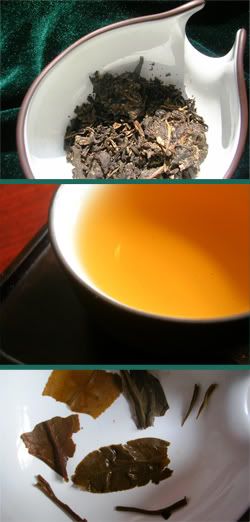I also revisited "Sample 1" from MashalN, using much shorter infusions than my initial session last time (notes to follow at some point) and found it rather enjoyable - along the lines of the 2 cakes he picked up in Shanghai.
For today's tea review, I quote another sample brewed just before I left home.
 This is a boxed tuocha sample, from Houde. Immediately, we think "high compression" and "tightly-boxed environment", both of which are hinderances to aging. Thankfully, the compression isn't at all tight, being rather unrepresentative of the usual Xiaguan concrete-like tuocha.
This is a boxed tuocha sample, from Houde. Immediately, we think "high compression" and "tightly-boxed environment", both of which are hinderances to aging. Thankfully, the compression isn't at all tight, being rather unrepresentative of the usual Xiaguan concrete-like tuocha.It is a jiaji [first grade] tea - the "CIB" is China's "Commodity Inspection Bureaux", indicating its higher grade due to its foreign export status.
~10cl Caledonian Springs @ 100C in 35cl shengpu pot; ~5g leaf; 1 rinse
Dry leaf:
Clearly a good grade: the leaves are small. There is a certain darkness about them, indicating that at least some aging has occurred over the past two decades. A sweet, high aroma pays testament to its constant dry storage. Unfortunately, my 10g sample is at least 50% fragmented leaves, which opens to the door to potential astringency - I try to brew short to avoid this.
5s, 10s, 10s, 20s, 25s, 30s, 40s, 50s, 90s:
A clean yellow-orange soup with plenty of tip-fur: jiaji indeed.
The aroma is, happily, "old": it opens sweet and deep, and has a long, leathery, sweet lengxiang. It is the exact aroma of the ancient old wooden-boxed croquet set that I used to play with as a child, which was my mother's childhood toy before that.
The flavour, sadly, is not quite up to the promises of the aroma. The fragmented leaves make the ku rather punishing, and it is particularly strong in relation to the limited pleasures of the quiet flavour. What is available is long and sweet, ending in the leatheriness that remains in the throat and nose.
This is a "fine" tea, it is clearly of a high quality, as evinced by its slippery texture and general air of age, but has not the strength of flavour that one would look for in a good tea.
It is, like many Xiaguan tuocha, under-matured for its age - presumably due to the box, in this case.
Wet leaves:
Generally small grades, yet almost entirely fragmented. The majority are surprisingly green.
Overall:
Sharp ku rides over a fine, but ultimately uninteresting flavour. Warming chaqi. I won't comment on the price:quality ratio, as I'm probably beginning to sound repetitive in that regard.
This cake is a good lesson in selecting cakes for aging: good, robust, deep flavours should be present in a tea when young, because if they are lacking (as in this tea), the result will be rather unfulfilling.

2 comments:
I think we need to hear more about the Sezhong + tieguanyin!
Time and tide wait for no man... :)
Post a Comment